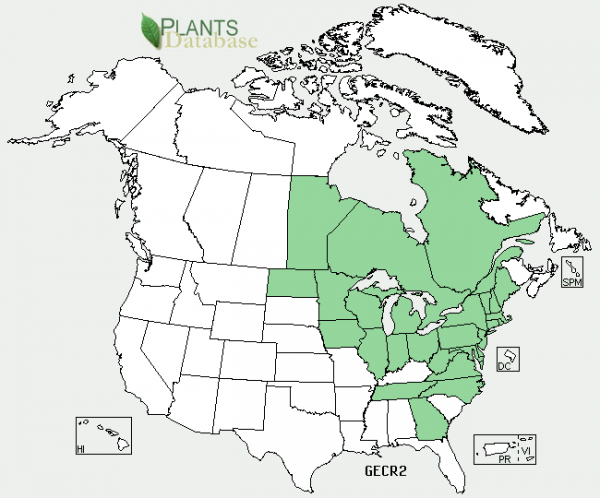
Gentianopsis crinita distribution, shown in green. Map courtesy of US Department of Agriculture.
The following section on growing Gentianopsis from seed and all photos contained therein were created by Gene Mirro and first appeared in the Rock Garden Quarterly.
The fringed Gentian, Gentianopsis crinita, is native over a vast area of eastern North America. It is annual or biennial, and reaches a height of one to three feet when flowering in September or October. It grows naturally in moist areas in full or partial sun, in a soil high in lime. It is becoming rare over much of its range.
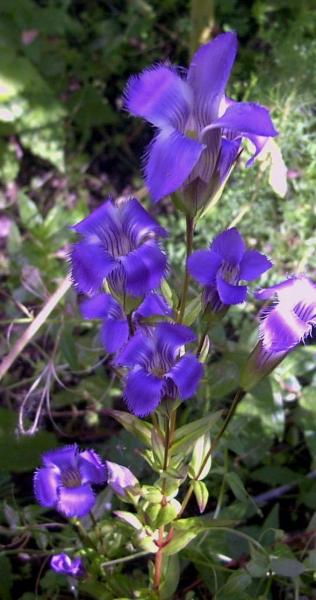 I have seen several references to the great difficulty of growing this plant in the garden. After much trial and error, I have found a way to reliably grow this plant from seed with nearly 100% success. In my opinion, they are much easier than the perennial Gentians. This method has also worked with Gentianopsis grandis and Gentianella detonsa.
I have seen several references to the great difficulty of growing this plant in the garden. After much trial and error, I have found a way to reliably grow this plant from seed with nearly 100% success. In my opinion, they are much easier than the perennial Gentians. This method has also worked with Gentianopsis grandis and Gentianella detonsa.
Germination: Nearly every Internet source I have read states that the seeds require winter chilling, after which germination occurs in Spring. This seems reasonable, since the plant flowers and sets seed so close to Winter. However, Norman Deno recommends 70 degrees F with GA-3 and darkness, with germination occurring in two weeks. Many years ago, I asked Jack Poff, grower at the Berry Botanic Garden, about this plant, and he said it would germinate in one month at 60 degrees F. I have tried the winter chilling approach, and have gotten some seeds to germinate, but germination percentage has always been low for me with this method. I have also tried sowing them in the Fall at around 60 degrees F. The seeds germinate strongly, but the tiny seedlings grow very slowly, and losses over the Winter are very high. I then decided to germinate them in the Fall, and then grow them under flourescent lights over the Winter. This method has been very successful. There have been several lots of seed where 80% or more of the seeds germinate and grow to flowering size. They do not require darkness; I germinate them under fluorescent lights. That way, they do not have a chance to get elongated and weak.
My experience with Gentians is that warm temperatures will weaken or kill the seedlings, so I germinate and grow them at 55 to 60 F. Remember that Deno's recommended temperature of 70F is for germination, and may not be the optimum for growing the seedlings.
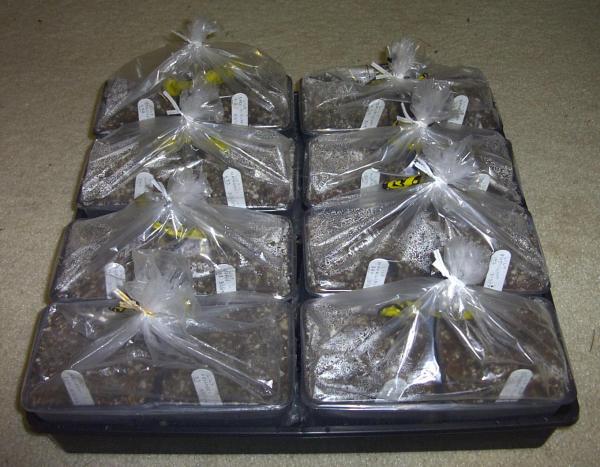 I am using two techniques that may be new to some rock gardeners. One is that I sow the seeds in a container, and then place that container in a sealed plastic bag, which I then place roughly 6" under the fluorescent lights. The resulting "terrarium" environment is very conducive to germination. One would think that it would also be conducive to damping off. In fact, I have observed that seedlings grown in the open air show damping off symptoms to a much greater extent than those grown in a sealed plastic bag. I can't explain this. After most of the seeds have germinated (in about one month), I partially open the plastic bag to allow some air flow. I do not want the tiny seedlings to be wet. Even a partially open bag will be very humid inside, which the seedlings seem to enjoy. After the first true leaves are well formed, I remove the container from the plastic bag, and place it under the lights.
I am using two techniques that may be new to some rock gardeners. One is that I sow the seeds in a container, and then place that container in a sealed plastic bag, which I then place roughly 6" under the fluorescent lights. The resulting "terrarium" environment is very conducive to germination. One would think that it would also be conducive to damping off. In fact, I have observed that seedlings grown in the open air show damping off symptoms to a much greater extent than those grown in a sealed plastic bag. I can't explain this. After most of the seeds have germinated (in about one month), I partially open the plastic bag to allow some air flow. I do not want the tiny seedlings to be wet. Even a partially open bag will be very humid inside, which the seedlings seem to enjoy. After the first true leaves are well formed, I remove the container from the plastic bag, and place it under the lights.
The second unusual technique, at least for some, is the use of fluorescent lights in wintertime. I use cheap 48" shop light fixtures with cool white lamps. I set them up in the basement or in a room that will not get warmer than 60 degrees F. I recommend that you use some sort of white reflecting panels around the perimeter, to reflect light back towards the plants. I use the rigid white insulating foam sheets that are readily available.
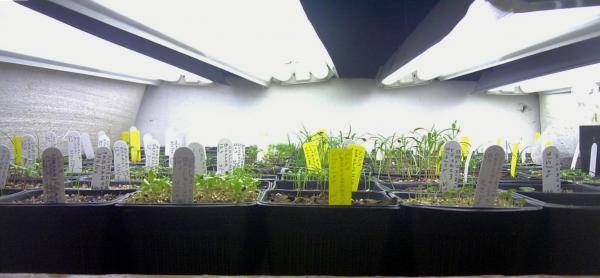 I have been growing seedlings under fluorescents for over 20 years, and I highly recommend it to all serious growers. An endless variety of plants will do well under lights at 60F. I have had some low-growing alpine plants bloom and set seed under lights in Winter. They love the cool temps.
I have been growing seedlings under fluorescents for over 20 years, and I highly recommend it to all serious growers. An endless variety of plants will do well under lights at 60F. I have had some low-growing alpine plants bloom and set seed under lights in Winter. They love the cool temps.
Because the lights are in your basement or living area, all waste heat goes towards heating the house. In any case, the energy cost is very reasonable. I get a lot of pleasure from caring for the plants without having to brave the elements. If you set up your growing area roughly 2.5 feet above the floor, you will find that it is very comfortable to care for your plants without bending or kneeling. The cheap folding tables that are readily available at office supply stores are exactly the right height.
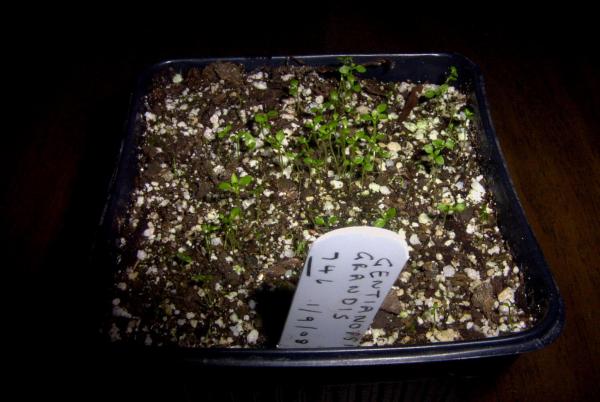 I keep the seedlings growing all Winter under the lights. They are tiny and slow, and require several months before they are transplant size. Sometime in Spring, I transplant them into 2.25" or 3.5" pots, depending on how big they are, and place them under the lights again, until they are well established in their new containers. I then place them out in the cool greenhouse in part shade for a couple of weeks to harden them off. After that, they can take nearly full sun, but do not allow the sun to heat up the container and the mix. They must not be allowed to go dry. Remember that they like lime and wet soil. Repot as needed to give them lots of room to develop. The healthiest plants will bloom in the Fall. The plants that do not bloom the first year may be kept in the unheated greenhouse over the winter, and will bloom the next Fall.
I keep the seedlings growing all Winter under the lights. They are tiny and slow, and require several months before they are transplant size. Sometime in Spring, I transplant them into 2.25" or 3.5" pots, depending on how big they are, and place them under the lights again, until they are well established in their new containers. I then place them out in the cool greenhouse in part shade for a couple of weeks to harden them off. After that, they can take nearly full sun, but do not allow the sun to heat up the container and the mix. They must not be allowed to go dry. Remember that they like lime and wet soil. Repot as needed to give them lots of room to develop. The healthiest plants will bloom in the Fall. The plants that do not bloom the first year may be kept in the unheated greenhouse over the winter, and will bloom the next Fall.
If you want to collect seed, you may need to hand-pollinate. Since the seed ripens very late, greenhouse growing is very advantageous.
I find that it is very difficult to keep these plants alive in the garden. They cannot stand to be in dry soil, and they mysteriously disappear over the Winter. I grow them exclusively in the greenhouse.
Here is a step-by-step procedure:
- Make a potting mix of 50% sphagnum peat and 50% perlite. Or use your own favorite moisture-retentive mix; they don't seem to be too fussy about the mix. To each gallon of mix, add 3 teaspoons of dolomite lime and a teaspoon of bone meal. Place in a plastic bag with a little water. Close the bag and knead vigorously until the medium is uniformly moist.
- Select containers at least 3 inches deep. 4" Gage pots work well: www.gageindustries.com. Fill with mix to the top. Firm the mix. Refill to within 1/4 inch of the top.
- Distribute seed on the mix, no more than 16 seeds per square inch.
- Do not cover seed with mix.
- Water lightly to settle the mix around the seeds. Use a fine spray, not a watering can.
- Label the containers.
- Place the containers in small transparent plastic bags, preferably the type that uses tie wraps.
- Seal the bags closed with tie wraps or whatever.
- Place the bags in a shaded place at 55-60F, protected from birds, mice, etc. I place them directly under my fluorescent lights, about 5" below the bulbs.
- Check the containers every couple of days for above-ground growth. Also make sure the mix is not getting dry. Some seeds will germinate in a couple of weeks. Others will require a month or more.
- When growth commences, feed with a dilute liquid fertilizer and place in a cool (55-60F), bright location, such as under fluorescent lights in the basement, or in a cool greenhouse. Do not expose seedlings to full sun. I usually leave the pots in the plastic bag until the seedlings are well established, but I partially open the bag for ventilation.
- Apply liquid fertilizer every couple of weeks. Water regularly; don't let the mix dry out. As the seedlings grow stronger, they can take higher temperatures, but not full sun.
- When the seedlings are big enough to handle, you can transplant them into individual pots for growing on to full size. 2.5", 3.5" or 4" Gage pots are fine. The seedling roots must not be exposed to air for more than a minute, or they will dry and severely damage the plant's chances of survival. For growing on, I use a mix of equal parts soil, fir bark, peat, perlite and pumice, with ¼ part of vermiculite added, and some dolomite lime, bone meal, and Micromax trace element mix. If you don't have Micromax, buy some soluble fertilizer with trace elements added, and use it to feed your plants on a regular basis.
- To minimize transplant shock, place the pots with the newly transplanted seedlings into transparent plastic bags and seal them shut with tie-wraps. Or cover the seedlings with clear plastic for a few days.
- Place the pots under fluorescents or in 50% shade. Water and fertilize regularly.
-
By Fall, the plants should be 3-4" across, with a basal rosette of leaves:
One-year-old seedlings of Gentianella detonsa superba.
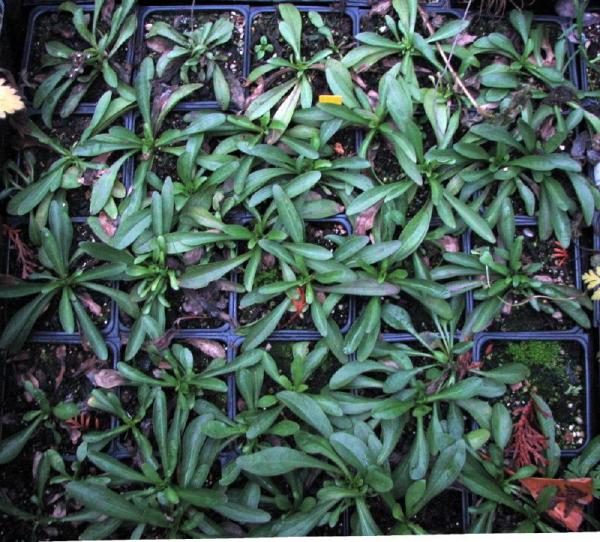 If the seed does not germinate by Winter, do not discard. Keep the container in the sealed plastic bag in a cold, shaded, protected place over Winter, and watch for germination in Spring. Keep the medium moist.
If the seed does not germinate by Winter, do not discard. Keep the container in the sealed plastic bag in a cold, shaded, protected place over Winter, and watch for germination in Spring. Keep the medium moist.
For those of you who do not want to bother with fluorescents, here is an alternative plan:
- Store the dry seed in an airtight container in the freezer until Spring.
- Sow the seed in Spring when the temperature gets up to 55–60F. Follow the instructions given above.
This method will give smaller plants than the Winter growing method, but you can always keep them for an extra year if necessary to get them up to flowering size.
If you can grow other plants with tiny, slow-growing seedlings, you should be successful with these. I don't know why they have such a bad reputation. It may be because the seed is reputed to be short-lived. I know from experience that this seed kept in the freezer will still be viable after 12 years or more. Or it may be that everyone is using the Winter chilling method and losing most of the seedlings. Solution: don't do that. Sow and grow at 60F.
Good luck !

